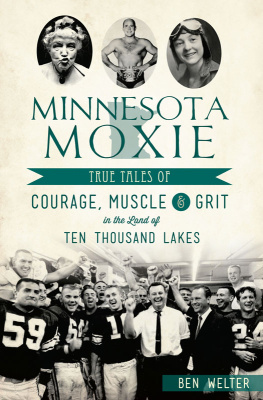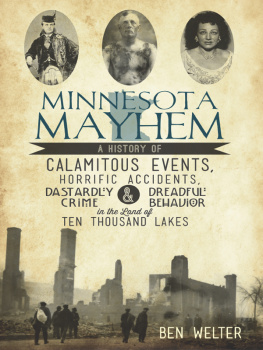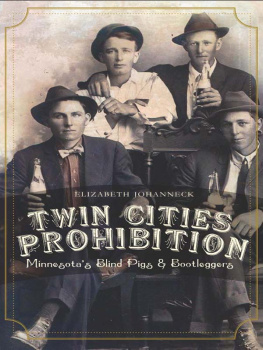

Published by The History Press
Charleston, SC
www.historypress.net
Copyright 2016 by Ben Welter
All rights reserved
First published 2016
e-book edition 2016
ISBN 978.1.43965.685.3
Library of Congress Control Number: 2016932970
print edition ISBN 978.1.46713.571.9
Some material in this book includes or is based on articles and photos first published in the Star Tribune newspaper (or its predecessors, the Minneapolis Star and Tribune, Minneapolis Star, Minneapolis Tribune, Minneapolis Star-Journal, Minneapolis Journal and Minneapolis Times) or on StarTribune.com. Those articles and photos are copyrighted by the Star Tribune Media Company LLC and are reprinted here with permission. The Star Tribune Media Company LLC retains certain copyright and syndication rights for those articles and photos.
Notice: The information in this book is true and complete to the best of our knowledge. It is offered without guarantee on the part of the author or The History Press. The author and The History Press disclaim all liability in connection with the use of this book.
All rights reserved. No part of this book may be reproduced or transmitted in any form whatsoever without prior written permission from the publisher except in the case of brief quotations embodied in critical articles and reviews.
CONTENTS
INTRODUCTION
The native peoples and immigrants who settled Minnesota were a tough lot. Blizzards, tornadoes, floods, drought, famine and disease took a heavy toll. But these challenges made our ancestors stronger, ready to face the stiffest test with determination and grace.
Inspiring stories are not hard to find. Many are preserved in the pages of Minnesota newspapers dating back more than 150 years. As an editor at the Star Tribune, I began combing these archives in 2005 in search of material for my blog, Yesterdays News (www.startribune.com/yesterday). In 10 years of blogging, I have posted hundreds of stories and more than one thousand photos and illustrations. Fresh interviews, background research and reader recollections flesh out many of the posts.
Minnesota Moxie, the third book based on my blog, is a collection of stories of strength, courage, tenacity and grit. These newspaper accounts are presented in their original form, along with photos from the archives of the Minnesota Historical Society, Hennepin County Library Special Collections, the Library of Congress, the University of Minnesota, the Memphis Public Library and the Star Tribune.
The lions share of the credit for this volume goes to the skilled, enterprising and mostly anonymous reporters and photographers who originally covered these stories. Credit also goes to the sharp-eyed editors on the Star Tribune copy deskmost notably Vince Tuss, Catherine Preus, Holly Collier Willmarth and Pam Hueywho checked my raw blog posts. They caught countless errors and offered excellent suggestions on titles, captions and research.
I dedicate this book to my own ancestors, who emigrated from Germany and Luxembourg in the nineteenth century. The Welters, Sinnens, Scholzes and Theises carved out better lives for themselves and their children. And they enriched Minnesota with their work ethic, faith, values and customs.
It is fitting to share one family tradition here. My parents, James and Mary Ann (Scholz) Welter, grew up during the Great Depression. In the 1970s, they revived from memory a German recipe that reflects the hardy, waste-not, want-not spirit of the immigrant. If you can make thisand eat ityou can meet any challenge.
German Liver Sausage
Makes forty pounds
7 pounds lean hamburger
5 pounds liver
16 cups onion, chopped
10 pounds pig hocks
20 pounds pork loin
FOR THE SEASONINGS:
7 tablespoons salt
10 teaspoons sage
7 teaspoons black pepper
5 teaspoons basil
3 teaspoons ground allspice
3 teaspoons ground cloves
3 teaspoons marjoram
2 teaspoons dry mustard
2 teaspoons thyme
5 leaves crushed rosemary
Fry the hamburger and liver.
The onions can be fried or cooked with the hocks and the loin. We cook the hocks and loin in the oven using plastic turkeyroasting bagsthe meat in the bags and the bags surrounded with water in covered roasting pans.
Roast for about 5 hours at 325 degrees Fahrenheit. (For a smaller recipe, roasting time would be less.) The meat inside the bags should reach 200 degrees Fahrenheit. When done, the meat should fall off the bones.
Debone and grind the meat and onions.
Mix seasoning together in a cup. Pour half the spices over the meat and sprinkle with water. Mix and repeat with the remainder of spices. We put all the juice from cooking the meat back in the sausage.
We do not use casings. We store the sausage in plastic bags and boxes in the freezer. They last for three months.
JIM AND MARY ANN WELTER
Richfield, Minnesota, 1986
JOHN L. SULLIVANS SLUGGING SHOW
NOVEMBER 27, 1883 DAILY MINNESOTA TRIBUNE
In November 1883, heavyweight boxing champion John L. Sullivan brought his touring band of noted pugilists to St. Pauls Market Hall for an exhibition of man-size action. Sullivan made quick work of a St. Paul man who had the courage to challenge the Boston Strongboy for a $500 prize. The Daily Minnesota Tribune reported that the fighters wore white stockings, pink knee breeches and gaitersbut didnt mention gloves.
An immense crowd gathered in Market Hall last night to witness the boxing exhibition given by [John L.] Sullivan and his company of noted pugilists. The audience was of the mixed variety that usually greets such a performance, ranging from the prominent business man down to the rag-tag and bob-tail. Frank Morden was master of ceremonies, and first introduced Mike Gillespie of Boston and Taylor, ex-champion of the world. The contestants were dressed in regular ring costume with white stockings, knee breeches and gaiters. Above the waist they wore bare.
The next set-to was not on the program, and was an unexpected treat to those present. It consisted of a contest between Morris Hasey and Sullivan, the former having expressed a desire to stand up four rounds before Sullivan for the standing prize of $500. Sullivan appeared in fine condition, strong, active and wiry as a squirrel. He was dressed in pink knee breeches, white stockings and gaiters. He turns the scales at 226 pounds. Hasey, a resident of St. Paul, a six-footer weighing 195 pounds, muscular and well formed, but bearing no comparison to the champion.

John L. Sullivan returned to Minnesota in 1887 to fight Patsy Cardiff at the Washington Roller Rink in Minneapolis. Sullivan suffered a broken left arm in that bout but managed to fight to a draw. Library of Congress.
He is a stationary engineer by trade. Time was called and no sooner had Hasey toed the scratch than Sullivan stretched out his arm and Hasey fell on the stage as if struck by an axe. He exhibited nerve, however, and desired to test his powers again, but as soon as he got within reach the champion knocked him over like a flash. He fell against the stage, and uttered a gasp or two and it was evident that he had had sufficient. Sullivan then addressed the audience and told them that Hasey had been boasting about how long he could stay with him. You see how long he has done it, the champion slugger said.
Next page










